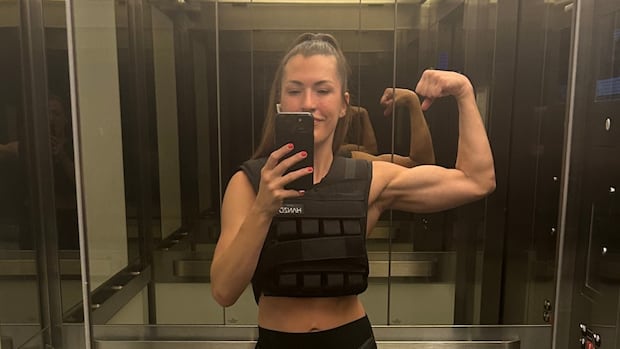The CurrentIs a weighted vest right for you?
Fitness trainer Kalli Youngstrom thinks weighted vests can be a great tool for fitting exercise into your daily routine — as long as you don’t mind looking like a Navy SEAL on the school run.
“It looks like a SWAT vest. It gets a lot of looks when I’m out in public,” said the Montreal-based wellness coach.
That bulky flak-jacket look is in part because of the many pockets for adding or removing weights from the vest, which sells from $25 to $200.
Youngstrom wears one to raise her heart rate and increase the intensity when she exercises. She recommends them to her clients, in particular busy mothers who don’t have time for a full workout. Strapping it on can upgrade an everyday task like walking the dog or taking the stroller to the park, she said.
“It’s the convenience and just adding a little bit of intensity to something that might be less of a workout otherwise,” she said, adding that she uses the vests in her own workouts.
The workout accessory has increased in popularity over the past year, with fitness influencers extolling a wide range of benefits from improved cardiovascular fitness to better bone density.
But one researcher warns that those benefits could be oversold online.
“If wearing a weighted vest gets you excited to go for a walk, then I’m all for it,” said Lauren Colenso-Semple, a muscle physiology researcher.
“But I just think we need to be honest about the benefits and what the data says.”
Claims may be misguided: expert
Colenso-Semple has seen influencers referencing studies on the benefits of weighted vests, but says that those studies are sometimes too small to draw significant conclusions, or are looking at more robust exercises other than simply walking.
“If you think about doing a squat or doing a lunge, then that is going to stimulate muscle growth if you do that under load,” she said.
“When you’re walking, you’re not moving through a full range of motion and contracting the muscle … it’s not enough of a stimulus for muscle.”
She said she also sees people posting device counts of how many extra calories they burn while wearing a weighted vest, but warned that the smartwatches people use to track those calories aren’t that accurate.
“It can certainly make the walk feel more challenging, but … you could also just walk faster. You could also walk up a hill,” she said.
Colenso-Semple said she finds it frustrating to see misguided or misleading claims online, because she thinks the truth of building healthier habits is “kind of simple.”
“By making [the issue] overcomplicated, by trying to put a huge price tag on it, it makes it much more difficult for women to navigate.”
A new fitness trend, dubbed ‘Japanese walking’ by some TikTokers, is starting to gain popularity. The trend is inspired by a 2007 study conducted by a Japanese research group that found some health benefits by alternating between high-intensity and moderate paced walking.
Tailor training to reach your goals
Colenso-Semple said it’s important to pause and think about your health and fitness goals.
“If we want to build muscle, if we want to improve bone, if we want to lose weight, then we tailor the exercise appropriately so that we are working towards that goal,” she said.
She said the best thing to build muscle and to improve bone density is to incorporate weight lifting into your exercise regime.
She doesn’t think wearing a weighted vest for walking does any major harm — unless the wearer finds it uncomfortable or it leads to back strain — but warned that if people are expecting the same benefits from lifting weights, “then that’s misguided.”
If you do intend to make weighted vests part of your exercise regime, Montreal trainer Youngstrom suggests people start with a vest of 5 to 10 per cent of their body weight.
An adjustable one will allow people to increase the weight as they gain strength, she added.
“The goal isn’t to carry as much weight as possible. It’s just to add a little bit of extra challenge safely,” she said.








